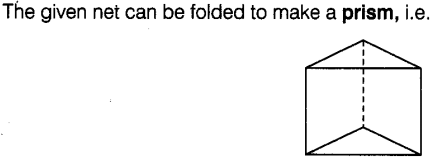NCERT Exemplar Class 8 Maths Chapter 6 Visualising Solid Shapes are part of NCERT Exemplar Class 8 Maths. Here we have given NCERT Exemplar Class 8 Maths Chapter 6 Visualising Solid Shapes.
NCERT Exemplar Class 8 Maths Chapter 6 Visualising Solid Shapes
Multiple Choice Questions
Question. 1 Which amongst the following is not a polyhedron?

Solution.
(c) According to the definition of a polyhedron, option (c) figure does not satisfies the condition of a polyhedron.
Since, a solid is a polyhedron if it is made up of only polygonal-faces, the faces meet at edges with one line segment and the edges meeting at a point. The point is generally called as vertex. But all the faces of option (c) are not polygons, there is a
circular base, so the figure is not a polyhedron.
Question. 2 Which of the following will not form a polyhedron?
(a) 3 triangles (b) 2 triangles and 3 parallelograms
(c) 8 triangles (d) 1 pentagon and 5 triangles
Solution.
(a) A polyhedron is bounded by more than four polygonal faces. But in case of 3 triangles, it is not possible. So, option (a) does not form a polyhedron.
Question. 3 Which of the following is a regular polyhedron?
(a) Cuboid (b) Triangular prism
(c) Cube (d) Square prism
Solution.
(c) A polyhedron is regular, if its faces are congruent regular polygons and the same number of faces meet at each vertex. Hence, a cube satisfies- all the properties for a regular polyhedron.
Question. 4 Which of the following is a two dimensional figure?
(a) Rectangle (b) Rectangle prism
(c) Square pyramid (d) Square prism
Solution.
(a) A two dimensional figure have two dimensions (measurements) like length and breadth. In the given options, only rectangle has two dimensions, i.e. length and breadth.
Question. 5 Which of the following can be the base of a pyramid?
(a) Line segment (b) Circle (c) Octagon (d) Oval
Solution.
(c) Since, a pyramid is a polyhedron whose base is a polygon and lateral faces are triangles.
Hence, octagon can be the base of a pyramid.
Question. 6 Which of the following 3-D shapes does not have a vertex?
(a) Pyramid (b) Prism (c) Cone (d) Sphere
Solution.
(d) As we kndw that, a vertex is a meeting point of two or more edges. Since, a sphere has only one curved face, so it has no vertex and no edges.
Question. 7 Solid having only line segments as its edges is a
(a) Polyhedron (b) Cone (c) Cylinder (d) Polygon
Solution.
(a) In polyhedron, the faces meet at edges which are line segments and edges meet at vertex. –
Question. 8 In a solid, if F = V = 5, then the number of edges in this shape is
(a) 6 (b) 4 (0 8 (d) 2
Solution.
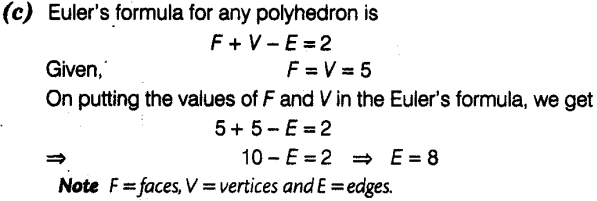
Question. 9 Which of the following is the top view of the given shape?
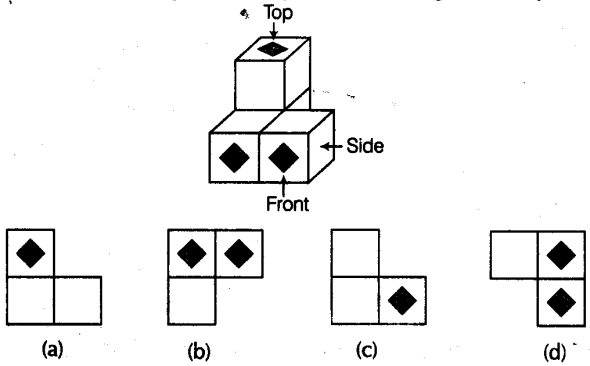
Solution.
(a) Since, top view is the picture of the solid which is seen from the top of the given figure. Therefore, the option (a) figure will be the top view, i.e.,

Question. 10 The net shown below can be folded into the shape of a cube. The face marked with the letter L is opposite to the face marked with which letter?

Solution.
(a) Clearly, the given net is a cube. If we fold it into a cube, then N will face opposite to R Q on the top and 0 on the bottom. So, L faces opposite to M.
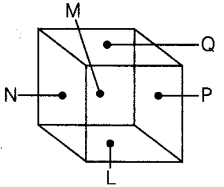
Question. 11 Which of the nets given below will generate a cone?

Solution.
(a) Option (a) net diagram gives a cone because other options has no circular base.
Since, a cone is a solid figure which has a circular base and it tapers from a circular base to a point called vertex.
Question. 12 Which of the following is not a prism?

Solution.
(b) We know that, a prism is a polyhedron whose bottom and top faces are congruent polygons and faces known as lateral faces are parallelograms. Clearly in option (b) figure, bottom and top faces are not congruent polygons and also lateral faces are not parallelograms.
Question. 13 We have 4 congruent equilateral triangles. What do we need more to make a pyramid?
(a) An equilateral triangle.
(b) A square with same side length as of triangle.
(c) 2 equilateral triangles with side length same as triangle.
(d) 2 squares with side length same as triangle.
Solution.
(b) We know that, a pyramid is a polyhedron, whose base is a polygon and lateral faces are triangles. But in the question, we have only 4 congruent equilateral triangles. Thus, we have to add a polygon in the base of atleast a four-sided figure.
Hence, option (b) is required to make a pyramid.
Question. 14 Side of a square garden is 30 m. If the scale used to draw its picture is 1 cm : 5 m, the perimeter of the square in the picture is
(a) 20 cm (b) 24 cm (c) 28 cm (d) 30 cm
Solution.

Question.15 Which of the following shapes has a vertex?

Solution.
(c) Figures given in options (a), (b) and (d) have no vertex but figure given in option (c), is a cone having a vertex. Since, vertex is a point where two or more edges meet.
Question. 16 In the given map, the distance between the places is shown using the scale 1 cm: 0.5 km. Then the actual distance (in km) between school and the book shop is

Solution.
(d) Given, scale 1 cm = 0-5 km ,
The distance between school and the book shop shown in map is equal to 2.2 cm. So, the actual distance between them will be = 2.2 x 0.5 km
= 1.1 km
Question .17 Which of the following cannot be true for a polyhedron?
(a) V = 4, F = 4, E = 6 (b) V=6,F=8,E=12
(c) V = 20,F = 12, E = 30 (d) V = 4, F = 6, E = 6
Solution.
(d) We know that, Euler’s formula for any polyhedron isF+V-E = 2
where, F = faces, V = vertices
and E =edges
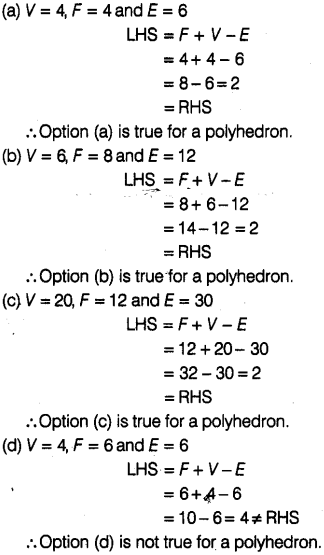
Question. 18 In a blueprint of a room, an architect has shown the height of the room as 33 cm. If the actual height of the room is 330 cm, then the scale used by her is
(a) 1:11 (b) 1 : 10
(c) 1:100 (d) 1 : 3
Solution.
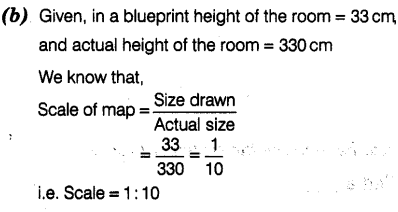
Question. 19 The following is the map of a town. Based on it answer questions 19-21.
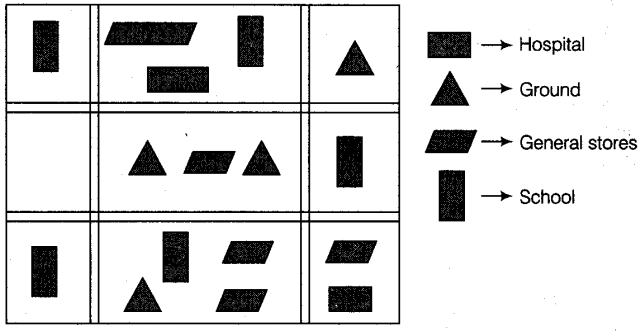
The number of hospitals in the town is
(a) 1 (b) 2 (c ) 3 (d) 4
Solution.

Question. 20 The ratio of the number of general stores and that of the ground is
(a) 1:2 (b) 2 : 1
(02:3 (d) 3 : 2
Solution.

Question. 21 According to the map, the number of schools in the town is
(a) 4 (b) 3
(c) 5 (d) 12
Solution.

Fill in the Blanks
In questions 22 to 41, fill in the blanks to make the statements true.
Question. 22 Square prism is also called a______
Solution.
Square prism is called a cube.
We know that, a square prism has a square base, a congruent square top and the sides are parallelograms. So, it is also a cube.
Question. 23 Rectangular prism is also called a______
Solution.
Rectangular prism is also called a cuboid. Since, a rectangular prism has 8 vertices, 12 edges and 6 rectangular faces as cuboid shown in below figure.

Question. 24

Solution.
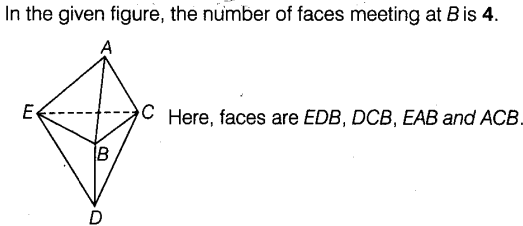
Question. 25 A pyramid on an n sided polygon has______faces.
Solution.
A pyramid on an n sided polygon has n + 1 faces.
We know that, in a pyramid, the number of faces is 1 more than the number of sides of the polygohal base.
Question. 26 If a solid shape has 12 faces and 20 vertices,then the number of edges in this solid is______
Solution.

Question. 28 A solid figure with only 1 vertex is a______
Solution.
A solid figure, with only 1 vertex is a cone. We know that, cone is a solid figure which has a circular base and its all other surfaces comes to a point called vertex.

Question . 29 Total number of faces in a pyramid which has eight edges is______
Solution.
Total number of faces in a pyramid which has eight edges is 5, i.e.

Question. 30 The net of a rectangular prism has ______rectangles.
[Hint Every square is a rectangle but every rectangle is not a square]
Solution.
The net of a rectangular prism is
Hence, net of a rectangular prism has 6 rectangles.
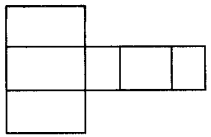
Question. 31 In a three-dimensional shape, diagonal is a line segment that joins two vertices that do not lie on the______face.
Solution.
In a three-dimensional shape, diagonal is a line segment that joins two vertices that do not lie on the same face.
Question. 32 If 4 km on a map is represented by 1 cm, then 16 km is represented by______cm.
Solution.
Given, 4 km on a map is represented by 1 cm, then 1 km on a map is represented by 1/4 cm.
Hence, 16 km on a map is represented by – x 16 = 4 cm
Question. 33 If actual distance between two places A and B is 110 km and it is represented on a map by 25 mm. Then the scale used is______
Solution.

Question. 34 A pentagonal prism has______faces.
Solution.
A pentagonal prism has 7 faces as shown in below figure

Question. 35 If a pyramid has a hexagonal base, then the number of vertices is______
Solution.
If a pyramid has a hexagonal base, then the number of vertices is 7.
We know that, in a pyramid the number of vertices is 1 more than the number of sides of the polygonal base.
Question. 36

Solution.
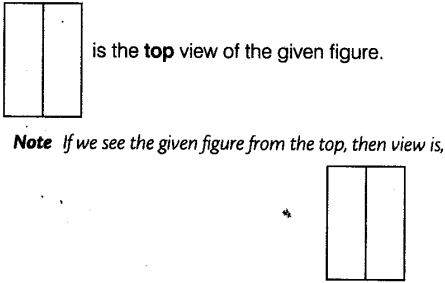
Question. 37

Solution.

Question. 38 If the sum of number of vertices and faces in a polyhedron is 14, then the number of edges in that shape is______
Solution.

Question. 39 Total number of regular polyhedron is______
Solution.
Total number of regular polyhedron is five, i.e. cube, octahedron, tetrahedron, dodecahedron and icosahedron.
Question. 40 A regular polyhedron is a solid made up of______faces.
Solution.
A regular polyhedron is a solid made up of congruent faces.
[according to the definition of regular polyhedron]
Question. 41 For each of the following solids, identify the front, side and top views and write it in the space provided.
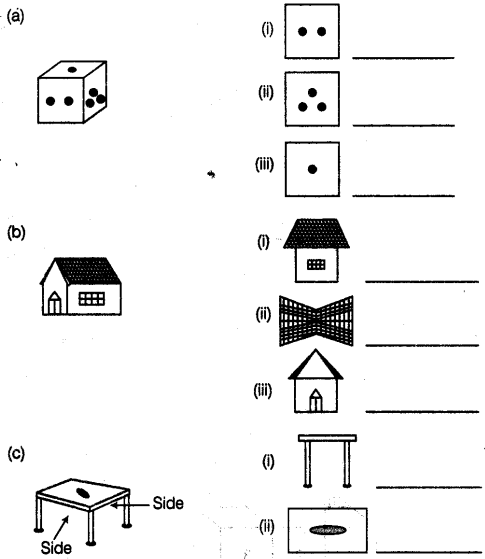
![]()

Solution.

True/False
In questions 42 to 61, state whether the following statements are True or False.
Question. 42 The other name of cuboid is tetrahedron.
Solution. False
The other name of cuboid is rectangular prism.
Question. 43 A polyhedron can have 4 faces.
Solution. False
A polyhedron can have atleast 4 faces.
Question. 44 A polyhedron with least number of faces is known as a triangular pyramid.
Solution. True
A polyhedron have atleast 4 faces and a four faced polyhedron is known as pyramid.

Question. 45 Regular octahedron has 8 congruent faces which are isosceles triangles.
Solution. False
A regular octahedron is obtained by joining two congruent square pyramids such that the vertices of the two square pyramids coincide. It has eight congruent equilateral triangular faces.
Question. 46 Pentagonal prism has 5 pentagons.
Solution. False
Pentagonal prism has 2 pentagons, one on the top and other on the base.
Question. 47 Every cylinder has 2 opposite faces as congruent circles, so it is also a prism.
Solution. False
The cylinder has a congruent cross-section which is a circle, so it could be called as a circular prism.
Question. 48 Euler’s formula is true for all three-dimensional shapes.
Solution. False
Euler’s formula is true only for polyhedrons,
i.e. F+V-E = 2
Where F = faces, V = vertices
and E = edges
Question. 49 A polyhedron can have 10 faces, 20 edges and 15 vertices.
Solution. False
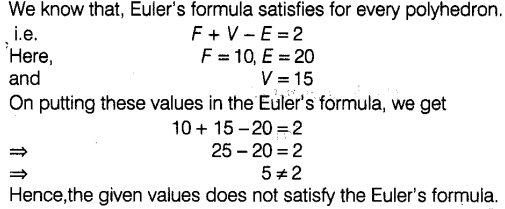
Question. 50 The top view of

Solution.

Question. 51 The number of edges in a parallelogram is 4.
Solution. True
AB, BC, CD and DA are the edges of a parallelogram ABCD.

Question. 52 Every, solid shape has a unique net.
Solution. False
A net is a flat figure that can be folded to form a closed, three-dimensional object. So, for an object, more than one net is possible but it is not true for the objects of all shapes.
Question. 53 Pyramids do not have a diagonal.
Solution. True ,
Pyramids are polyhedron with a polygon as its base and other faces as triangles meeting at a common vertex and diagonal is a line joining the two opposite vertex.
So, in pyramids, two opposite vertex cannot be formed.
So, we can say pyramids has no diagonal.
Question. 54 The given shape is a cylinder.
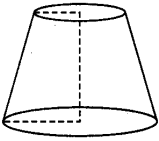
Solution.
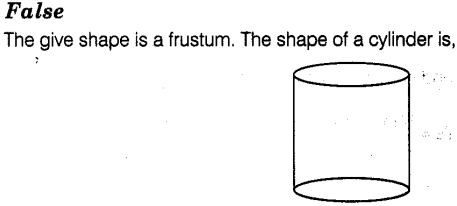
Question. 55 A cuboid has atleast 4 diagonals.
Solution. True
In a cuboid, the number of diagonals is not least then 4.
Question. 56. All cubes are prism.
Solution. True
A cube is a prism because it has a square base, a congruent square top and the lateral sides are parallelograms.
Question. 57 A cylinder is a 3-D shape having two circular faces of different radii.
Solution. False
In a cylinder, the radii of the two circular faces are same. If the radii of two circular faces are different, then it will become frustum.
Question. 58 On the basis of ttte given figure, the length of a rectangle in the net of a cylinder is same as circumference of circles in its net.

Solution.True
Since, the length of a rectangle in the net of a cylinder is same as circumference of circle in the given net.
Question. 59 If a length of 100 m i% represented on a map by 1 cm, then the actual distance corresponding to 2 cm is 200 m.
Solution. True
When a length 100 m is respresented on a map by 1 cm.
Then, actual distance corresponding to 2 cm = 2 x 100 = 200 m
Question. 60 The model of a ship shown is of height 3.5 cm. The actual height of the ship is 210 cm, if the scale chosen is 1 : 60.
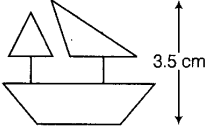
Solution.
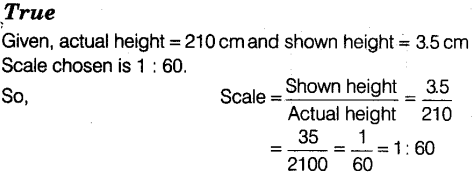
Question. 61 The actual width of a store room is 280 cm. If the scale chosen to make its drawing is 1 : 7, then the width of the room in the drawing will be 40 cm.
Solution.

Question. 62 Complete the table given below :
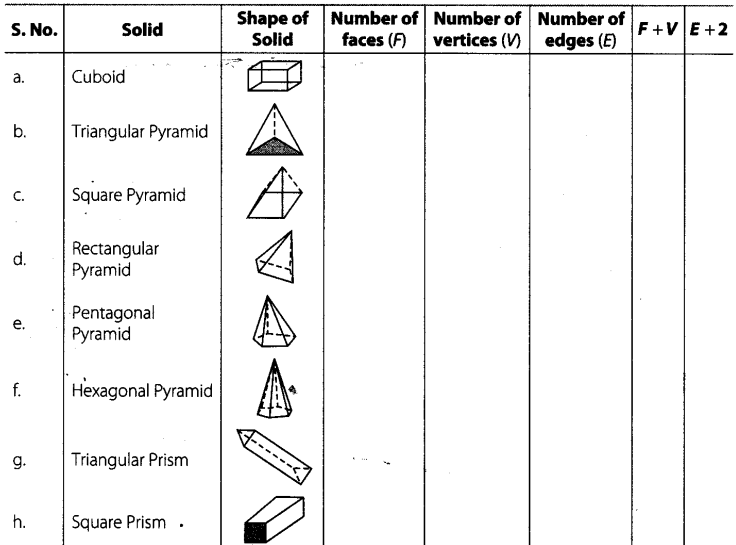
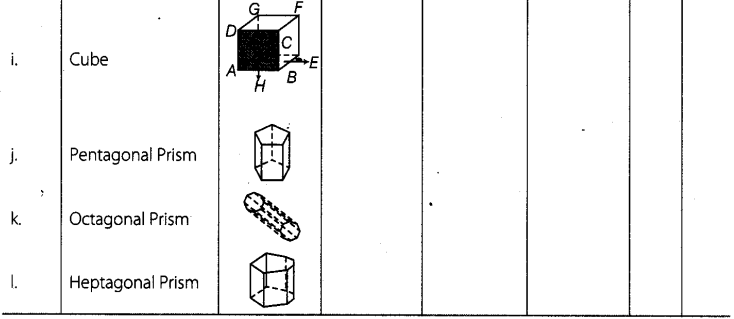
Solution. By using Euler’s formula for polyhedron,
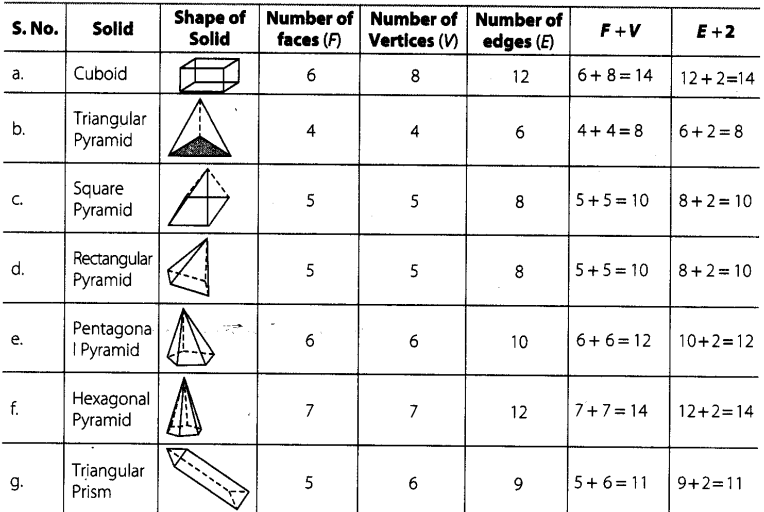
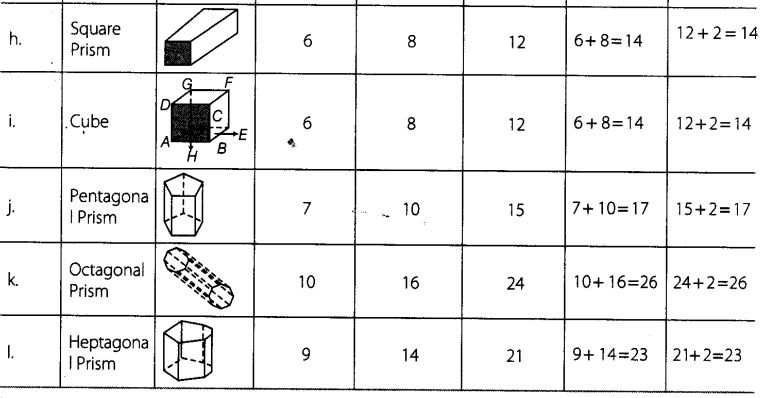
Question. 63 How many faces does each of the following solids have?
(a) Tetrahedron (b) Hexahedron
(c) Octagonal pyramid (d) Octahedron
Solution.

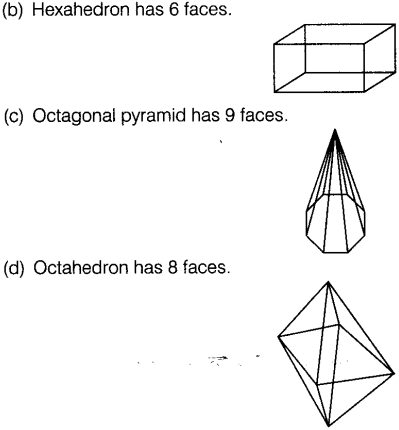
Question. 64 Draw a prism with its base as regular hexagon with one of its face facing you. Now draw the top view, front view and side view of this solid.
Solution.
The following figure shows a prism with its base as regular hexagon with one of its face to us. And also, we shows the top view, front view and side view of the prism.

Question. 65 How’ many vertices does each of the following solids have?
(a) Cone (b)Cylinder
(c) Sphere (d)Octagonal Pyramid
(e) Tetrahedron (f) Hexagonal Prism
Solution.


Question. 66 How many edges does each of following solids have?
(a) Cone (b)Cylinder
(c) Sphere (d)Octagonal Pyramid
(e) Hexagonal Prism(f)Kaleidoscope
Solution.
(a) Cone has one edge.
(b) Cylinder has two edges.
(c) Sphere has no edge.
(d) Octagonal pyramid has 16 edges.
(e) Hexagonal prism has 18 edges.
(f) Kaleidoscope has 9 edges.
Note See edges in previous question’s solution figures.
Question. 67 Look at the shapes given below and state which of these are polyhedra using Euler’s formula.
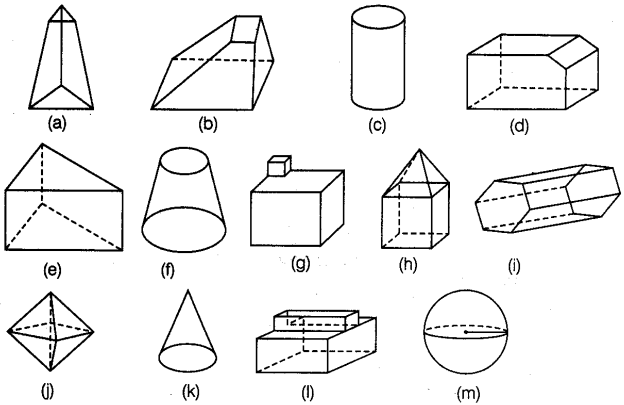
Solution.
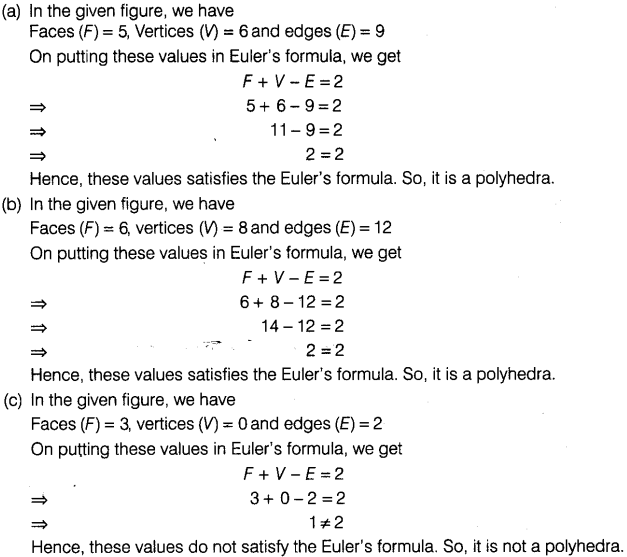
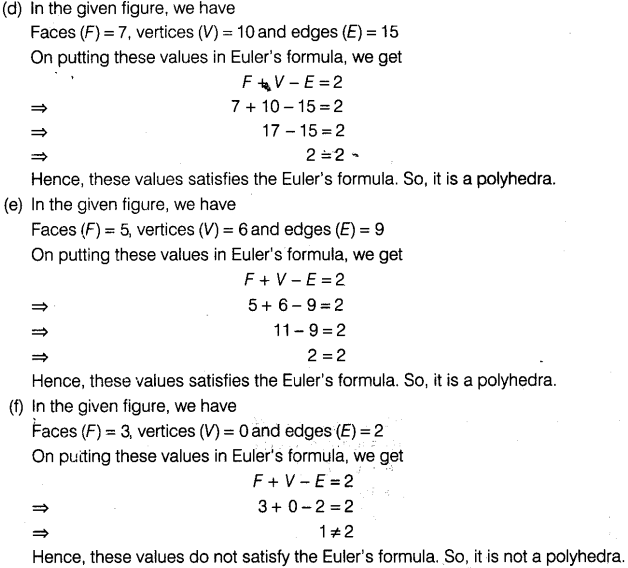
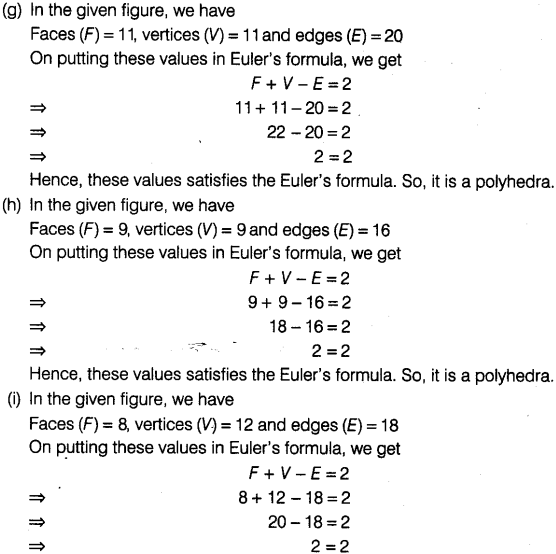


Question. 68 Count the number of cubes in the given shapes.
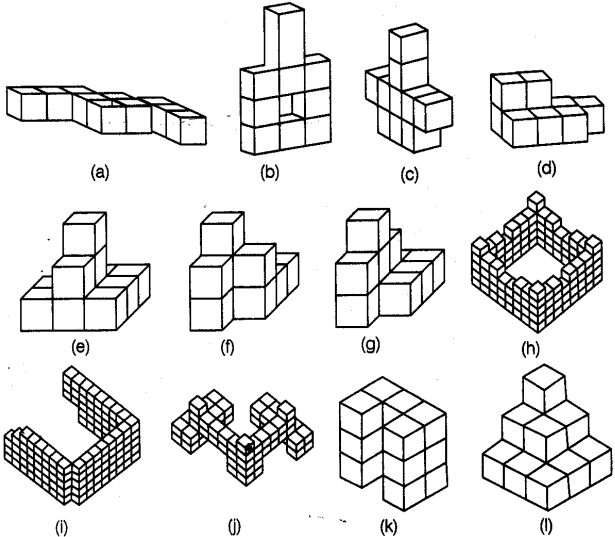
Solution.
For finding the number of cubes in the given shapes you have to count all cubes which are visible or not. Hence, we have the total number of cubes for the given figures as:
(a) 10 cubes (b)10 cubes
(c) 10 cubes (d) 9 cubes
(e) 11 cubes (f) 9 cubes
(g) 11 cubes (h) 110 cubes
(i) 113 cubes(j)66 cubes
(k) 15 cubes (l)14 cubes
Question .69 :Draw the front, side and top view of the given shapes.


Solution.
On the basis of properties and features of front view, top view and side view, we can draw all the three views of the given figures as:
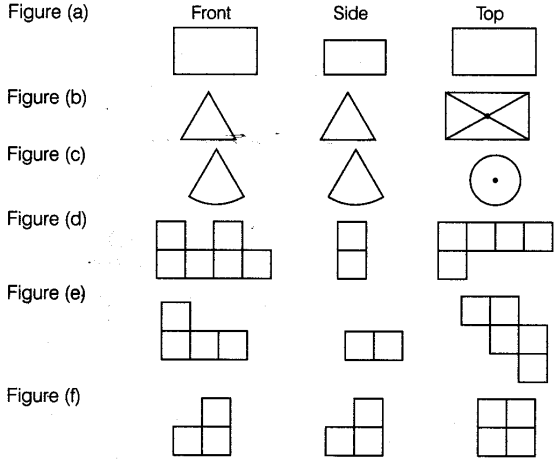
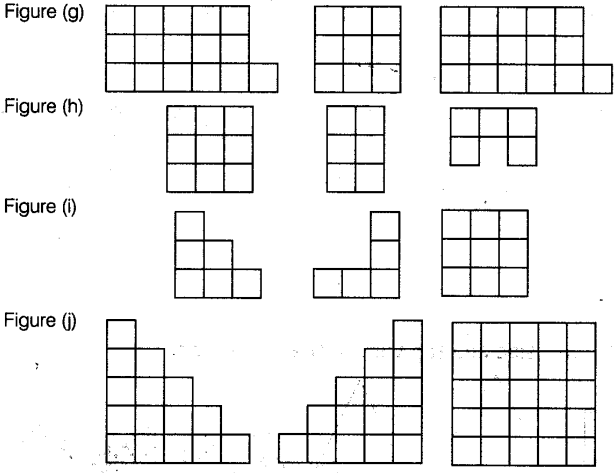
Question.70 Using Euler’s formula. Find the value of unknown x, y, z, p, q andr in the following table.

Solution.
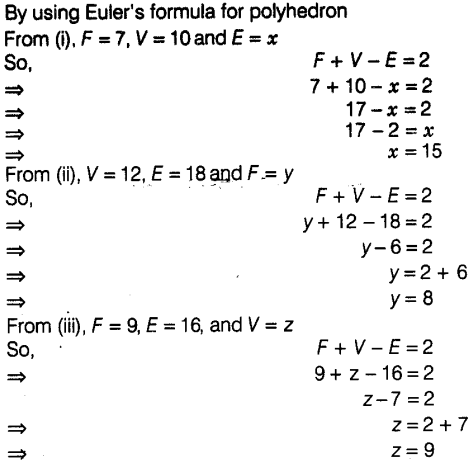
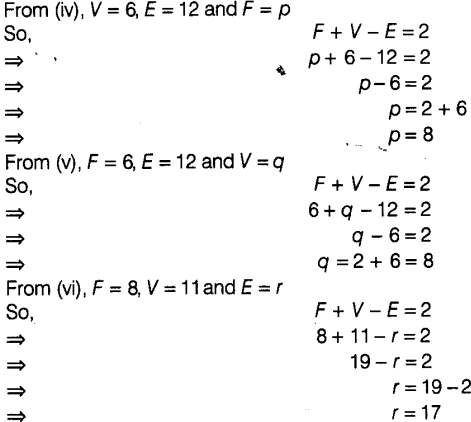
Question. 71 Can a polyhedron haveV = F = 9 and E = 16 ? If yes, draw its figure.
Solution.


Question. 72 Check whether a polyhedron can have V = 12,E = 6 and F = 8.
Solution.

Question. 73 A polyhedron has 60 edges and 40 vertices. Find the number of its faces.
Solution.

Question. 74 Find the number of faces in the given shapes.

Solution. In the first figure, the number of faces are equal to 14.
In the second figure, the number of faces are equal to 10.
In the third figure, the number of faces are equal to 16.
Question. 75 A polyhedron has 20 faces and 12 vertices. Find the edges of the polyhedron.
Solution.

Question. 76 A solid has forty faces and sixty edges. Find the number of vertices of the solid.
Solution.
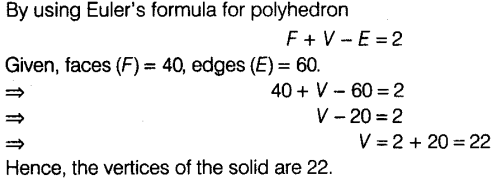
Question. 77 Draw the net of a regular hexahedron with side 3 cm. [Hint Regular hexahedron cube]
Solution. The net of a regular hexahedron with side 3 cm is given below:
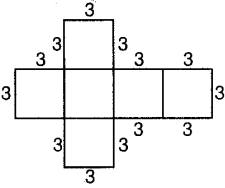
Question. 78 Draw the net of a regular tetrahedron with side 6 cm.
Solution. The net of a regular tetrahedron with side 6 cm is given below:
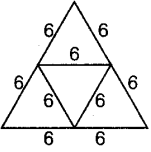
Question. 79 Draw the net of the following cuboid:
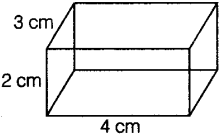
Solution. The net of the given cuboid is shown below:

Question. 80 Match the following
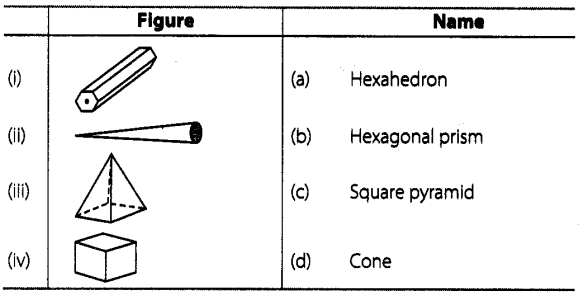
Solution.
In figure (i), the base and top both are the hexagonal polygons.
So, it is a hexagonal prism.
In figure (ii), only one vertexes available.
So, it is a cone.
In figure (iii), the base is square and rest four faces are equilateral triangles.
So, it is a square pyramid. .
In figure (iv), the base is square and it has 6 faces and 8 vertices. So, it is a hexahedron (cube). [Note Cube is also known as Hexahedron.]
Hence, the correct matching is as:
(i) -> (b) (ii) -> (d) (iii) -> (c) (iv) -> (a)
Question. 81
Complete the table given below by putting tick mark across the respective property found in the solids mentioned.
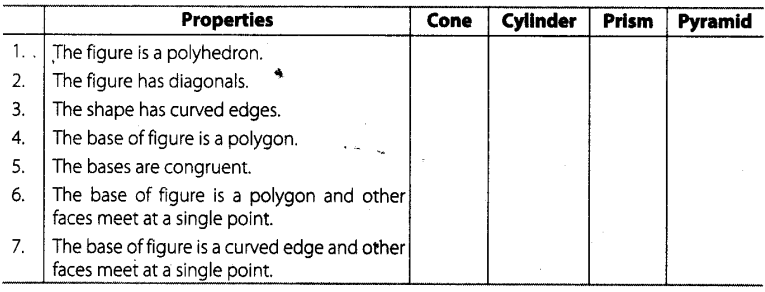
Solution.
On the basis of properties and features of cone, cylinder, prism and pyramid, we can fill the given table as follows:

Question. 82 Draw the net of the following shape.

Solution.

Question. 83 Draw the net of the following solid.
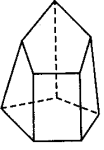
[Hint Pentagons are not congruent.]
Solution.
The net of the given solid is shown below:
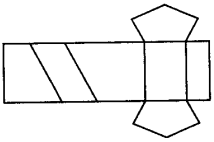
Note If we open this solid shape, we will find above net.
Question. 84 Find the number of cubes in the base layer of the following figure.

Solution.
The number of cubes in the the base layer of the given figure is 6.
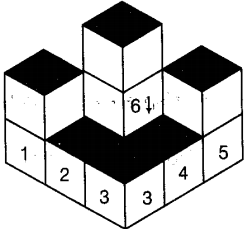
Question. 85 In the figure given in Q.84, if only the shaded cubes are visible from the top, draw the base layer.
Solution.
The top view of the figure is shown below:
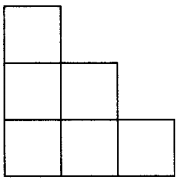
Note If we see the given figure from top, we will only see upper layer not base layer.
Question. 86 How many faces, edges and vertices does a pyramid have with n sided polygon as its base? _
Solution.
In a pyramid, the number of vertices is 1 more than the number of sides of the polygon base, i.e. vertices = n + 1
Also, the number of faces is 1 more than the number of sides of the polygonal base, i.e. faces = n+ 1
But the number of edges is 2 times the number of sides of the polygonal base, i.e. edges = 2 n .
Question. 87 Draw a figure that represents your mathematics textbook. What is the name of this figure? Is it a prism?
Solution.
The figure of our mathematics textbook is cuboid which is shown below. Also, we know that the another name of cuboid is a rectangular prism.

Question. 88 In the given figures, identify the different shapes involved.

Solution.
First figure is made by using a hemisphere and cylinder. In this figure, cylinder is mounted by hemisphere.
The second figure is made by using.aoone and hexagonal prism. In this figure, hexagonal prism is mounted by a cone.
Question. 89 What figure is formed if only the height of a cube is increased or decreased?
Solution.
If we only increase on decrease the height of a cube, the obtained figure is cuboid.
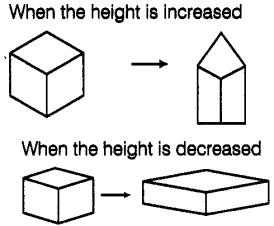
Question. 90 Use isometric dot paper to draw each figure.
(a) A tetrahedron..
(b) A rectangular prism with length 4 units, width 2 units and height 2 units.
Solution.
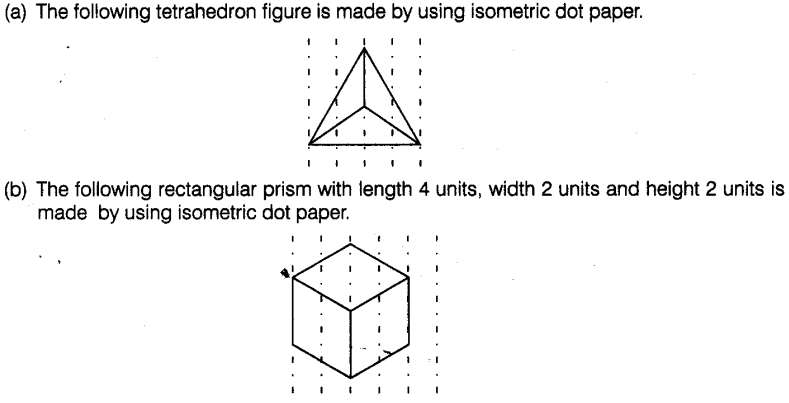
Question. 91 Identify the nets given below and mention the name of the corresponding solid in the space provided.
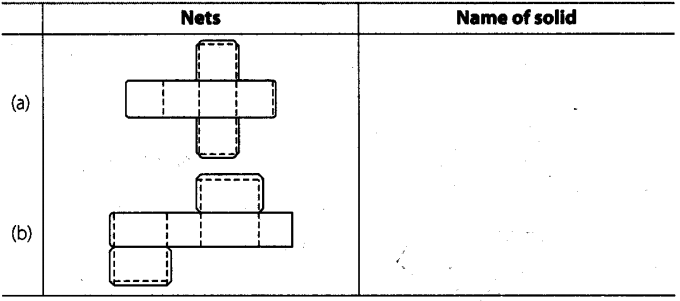
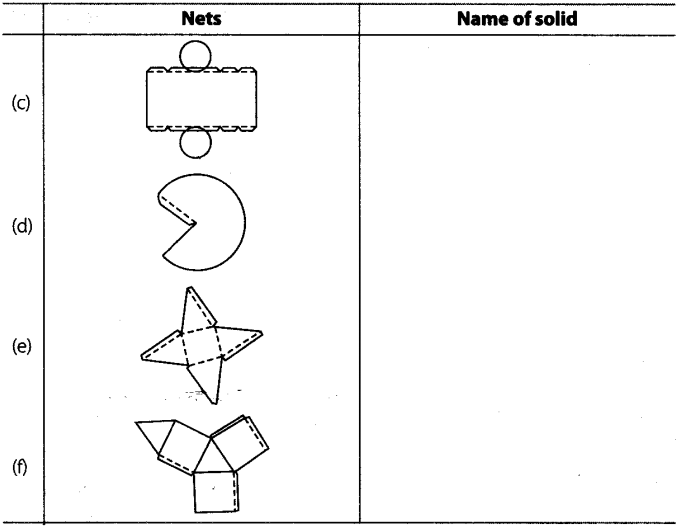
Solution.
On the basis of properties regarding drawing a net diagram of a solid figure, we can easily name the solid by using the net.
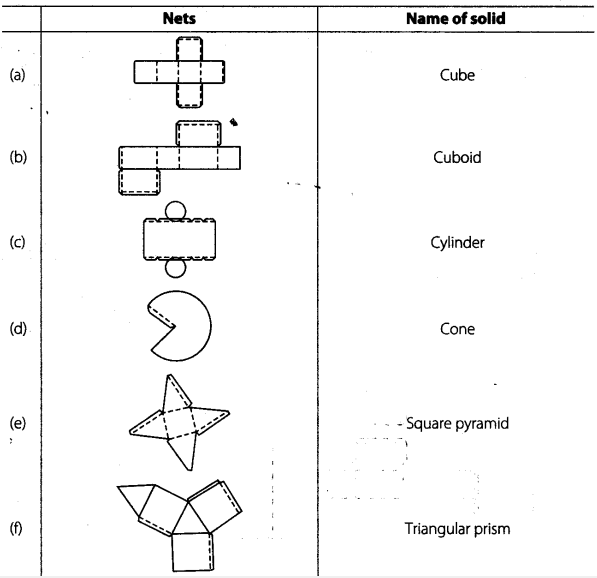
Question. 92 Draw a map of your school playground. Mark all necessary places like 2 Library, Playground, Medical Room, Classrooms, Assembly area, etc.
Solution.
A number of maps can be drawn for a school from which one map is given below :
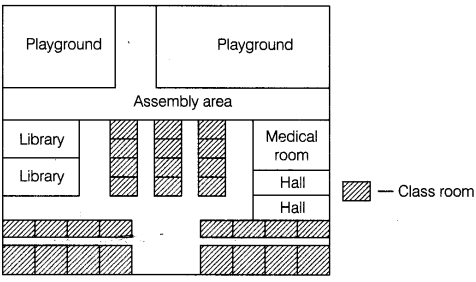
Question .93 Refer to the given map to answer the following questions.

(a) What is the built-up area of Govt. Model School I?
(b) Name the schools shown in the picture.
(c) Which park is nearest to the dispensary?
(d) To which block does the main market belong?
(e) How many parks have been represented in the map?
Solution.
If we see the given map, we can answer the given questions as:
(a) The built-up area of Govt. Model School I is equal to 2.1 acre.
(b) Two schools shown in the picture, Govt. Model School I and II.
(c) Part A is nearest to the dispensary.
(d) The main market belongs to block A.
(e) 6 parks have been represented in the map.
Question. 94 Look at the map given below.
Answer the following questions.
(a) Which two hospitals are opposite to each other?
(b) A person residing at Niti Bagh has to go to Chirag Delhi after dropping her daughter at Asiad Tower. Mention the important landmarks he will pass alongwith the roads taken.
(c) Name of which road is similar to the name of some month.
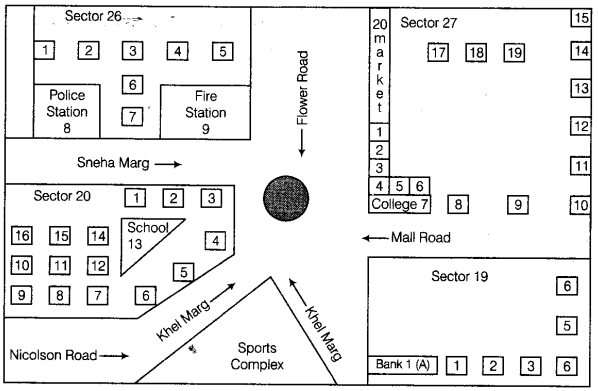
Solution.
The given map is not sufficient to answer these questions.
Question. 95 Loot at the map given below.
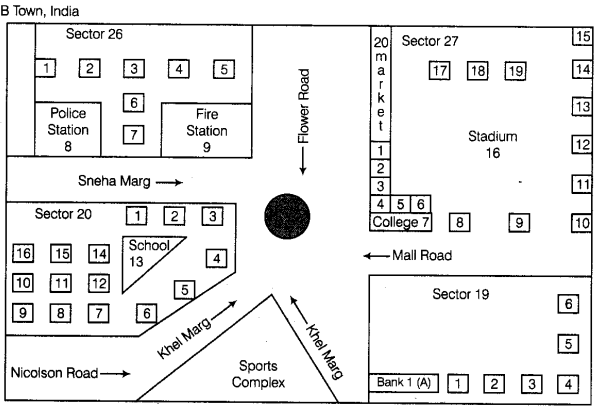
Now, answer the following questions.
(a) Name the roads that meet at round about.
(b) What is the address of the stadium?
(c) On which road is the Police Station situated?
(d) If Ritika stays adjacent to bank and you have to send her a card. What address will you write?
(e) Which sector has maximum number of houses?
(f) In which sector is Fire Station Located?
(g) In the map, how many sectors have been shown?
Solution.
Carefully see the map.
(a) Flower road, Khel marg, Mall road and Sneha marg meet at round.
(b) The address of the stadium is given below:
Sector 27.
BTown, India
(c) The police station is situated on Sneha marg.
(d) Sneha’s address is given below :
H.N-1Nr. Bank 1 (A)
Sector 19, B town, India
(e) Sector 27 has maximum number of houses.
(f) Fire station is located in sector 26.
(g) In the map, four sectors have been shown.
Question. 96 A photographer uses a computer program to enlarge a photograph. What is the scale according to which the width has enlarged?
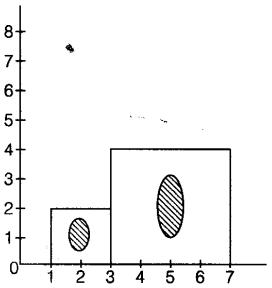
Solution.
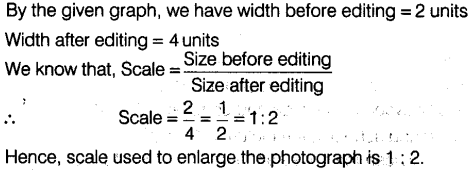
Question. 97 The side of a square board is 50 cm. A student has to draw its image in her notebook. If the drawing of the square board in the notebook has perimeter of 40 cm, then by which scale the figure has been drawn?
Solution.
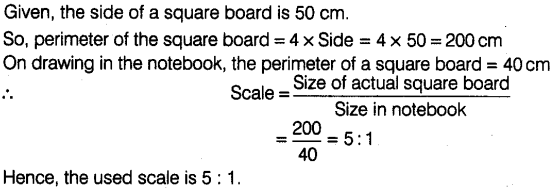
Question. 98 The distance between school and house of a girl is given by 5 cm in a picture, using the scale 1cm : 5 km. Find the actual distance between the two places?
Solution.

Question. 99 Use a ruler to measure the distance in cm between the places joined by dotted lines. If the map has been drawn using the scale, 1 cm : 10 km, find the actual distances between
(a) School and Library
(b) College and Complex
(c) House and School
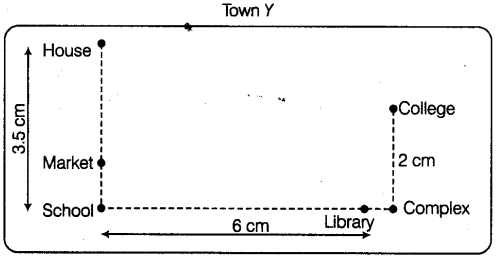
Solution.
Given scale is 1 cm : 10 km, i.e. 1 cm in a picture = 10 km of actual distance
(a) The distance between the school and libarary in the picture = 6 cm.
Hence, the actual distance between the school and library = 6 x 10 = 60 km
(b) Distance between the college and complex in the picture = 2 cm
Hence, the actual distance between the college apd complex = 2 x 10 = 20 km
(c) Distance between the house and school in the picture = 3.5 cm … Hencp, the actual distance between the house and school = 3.5 x 10 = 35 km
Question. 100 The’ actual length of a painting was 2m. What is the length in the photograph if the scale used is 1 mm : 20 cm.

Solution.

Question. 101 Find the scale,
(a) Actual size 12 m
. Drawing size 3 cm
(b) Actual size 45 feet Drawing size 5 inches
Solution.

Question. 102 In a town, an ice-cream parlour has displayed an ice-cream sculpture of height 360 cm. The parlour claims that these ice-creams and the sculpture are in the scale 1 : 30. What is the height of the ice-creams served? .
Hence, the height of thel ice-cream served is 12 cm.
Solution.

NCERT Exemplar Solutions Class 8 Maths
- Chapter 1 Rational Numbers
- Chapter 2 Data Handling
- Chapter 3 Square-Square Root and Cube-Cube Root
- Chapter 4 Linear Equations in One Variable
- Chapter 5 Understanding Quadrilaterals and Practical Geometry
- Chapter 6 Visualising Solid Shapes
- Chapter 7 Algebraic Expressions, Identities and Factorisation
- Chapter 8 Exponents and Powers
- Chapter 9 Comparing Quantities
- Chapter 10 Direct and Inverse Proportion
- Chapter 11 Mensuration
- Chapter 12 Introduction to Graphs
- Chapter 13 Playing with Numbers
We hope the NCERT Exemplar Class 8 Maths Chapter 6 Visualising Solid Shapes help you. If you have any query regarding NCERT Exemplar Class 8 Maths Chapter 6 Visualising Solid Shapes, drop a comment below and we will get back to you at the earliest.
<!–
–>

